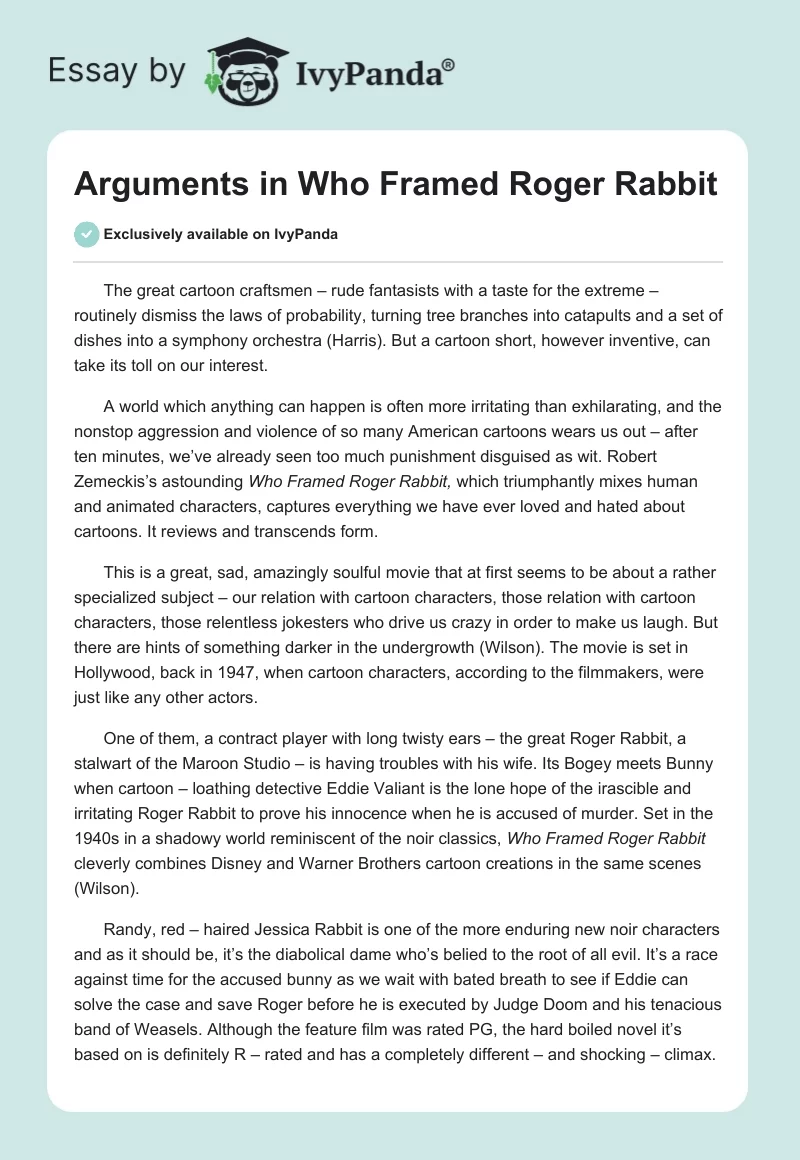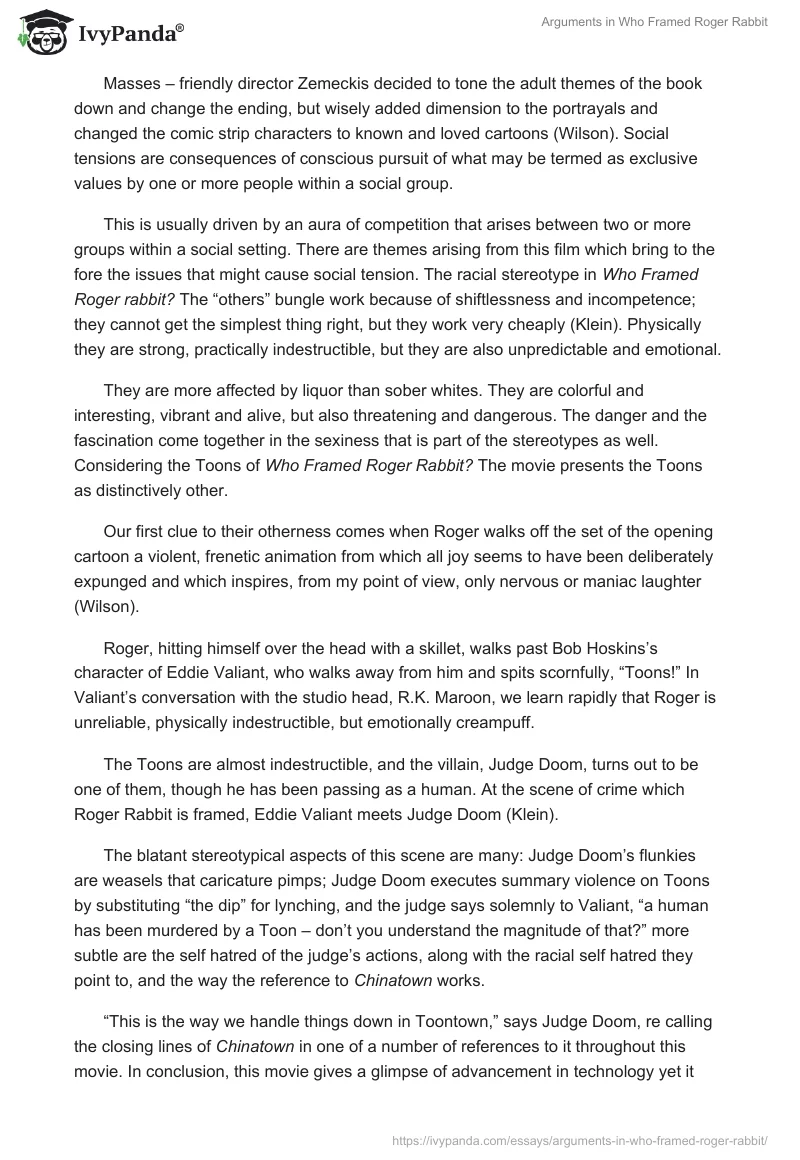The great cartoon craftsmen – rude fantasists with a taste for the extreme – routinely dismiss the laws of probability, turning tree branches into catapults and a set of dishes into a symphony orchestra (Harris). But a cartoon short, however inventive, can take its toll on our interest.
A world which anything can happen is often more irritating than exhilarating, and the nonstop aggression and violence of so many American cartoons wears us out – after ten minutes, we’ve already seen too much punishment disguised as wit. Robert Zemeckis’s astounding Who Framed Roger Rabbit, which triumphantly mixes human and animated characters, captures everything we have ever loved and hated about cartoons. It reviews and transcends form.
This is a great, sad, amazingly soulful movie that at first seems to be about a rather specialized subject – our relation with cartoon characters, those relation with cartoon characters, those relentless jokesters who drive us crazy in order to make us laugh. But there are hints of something darker in the undergrowth (Wilson). The movie is set in Hollywood, back in 1947, when cartoon characters, according to the filmmakers, were just like any other actors.
One of them, a contract player with long twisty ears – the great Roger Rabbit, a stalwart of the Maroon Studio – is having troubles with his wife. Its Bogey meets Bunny when cartoon – loathing detective Eddie Valiant is the lone hope of the irascible and irritating Roger Rabbit to prove his innocence when he is accused of murder. Set in the 1940s in a shadowy world reminiscent of the noir classics, Who Framed Roger Rabbit cleverly combines Disney and Warner Brothers cartoon creations in the same scenes (Wilson).
Randy, red – haired Jessica Rabbit is one of the more enduring new noir characters and as it should be, it’s the diabolical dame who’s belied to the root of all evil. It’s a race against time for the accused bunny as we wait with bated breath to see if Eddie can solve the case and save Roger before he is executed by Judge Doom and his tenacious band of Weasels. Although the feature film was rated PG, the hard boiled novel it’s based on is definitely R – rated and has a completely different – and shocking – climax.
Masses – friendly director Zemeckis decided to tone the adult themes of the book down and change the ending, but wisely added dimension to the portrayals and changed the comic strip characters to known and loved cartoons (Wilson). Social tensions are consequences of conscious pursuit of what may be termed as exclusive values by one or more people within a social group.
This is usually driven by an aura of competition that arises between two or more groups within a social setting. There are themes arising from this film which bring to the fore the issues that might cause social tension. The racial stereotype in Who Framed Roger rabbit? The “others” bungle work because of shiftlessness and incompetence; they cannot get the simplest thing right, but they work very cheaply (Klein). Physically they are strong, practically indestructible, but they are also unpredictable and emotional.
They are more affected by liquor than sober whites. They are colorful and interesting, vibrant and alive, but also threatening and dangerous. The danger and the fascination come together in the sexiness that is part of the stereotypes as well. Considering the Toons of Who Framed Roger Rabbit? The movie presents the Toons as distinctively other.
Our first clue to their otherness comes when Roger walks off the set of the opening cartoon a violent, frenetic animation from which all joy seems to have been deliberately expunged and which inspires, from my point of view, only nervous or maniac laughter (Wilson).
Roger, hitting himself over the head with a skillet, walks past Bob Hoskins’s character of Eddie Valiant, who walks away from him and spits scornfully, “Toons!” In Valiant’s conversation with the studio head, R.K. Maroon, we learn rapidly that Roger is unreliable, physically indestructible, but emotionally creampuff.
The Toons are almost indestructible, and the villain, Judge Doom, turns out to be one of them, though he has been passing as a human. At the scene of crime which Roger Rabbit is framed, Eddie Valiant meets Judge Doom (Klein).
The blatant stereotypical aspects of this scene are many: Judge Doom’s flunkies are weasels that caricature pimps; Judge Doom executes summary violence on Toons by substituting “the dip” for lynching, and the judge says solemnly to Valiant, “a human has been murdered by a Toon – don’t you understand the magnitude of that?” more subtle are the self hatred of the judge’s actions, along with the racial self hatred they point to, and the way the reference to Chinatown works.
“This is the way we handle things down in Toontown,” says Judge Doom, re calling the closing lines of Chinatown in one of a number of references to it throughout this movie. In conclusion, this movie gives a glimpse of advancement in technology yet it does so in a convincing and humorous manner that leaves the viewer both perplexed and amused.
This enhances the well being of a person who might be stressed owing to what a person may be going through at a given point in time. Owing to the ingenuity created in this movie, one cannot help but be caught in moments of laughter as Holt has previously stated that jokes are products of human ingenuity.
Works Cited
Harris, Judy. Time Capsule:Reviews of Horror, Science Fiction and Fantasy Films and TV Shows from 1987-1991. London: iUniverse, 2002.
Klein, Kathleen Gregory. Diversity and detective fiction. New York: Popular Press, 1999. Wilson, Staci Layne. Animal Movies Guide. New York: Staci Wilson, 2007


